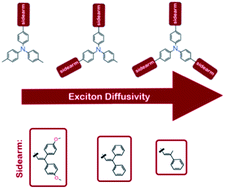Exciton diffusion enhancement in triphenylamines via incorporation of phenylethenyl sidearms†
Abstract
Exciton diffusion length strongly impacts the performance of organic photovoltaic cells and light emitting diodes, and therefore ways of manipulating the diffusion length must be sought out. Here, we present an approach for controlling singlet exciton diffusion in triphenylamine (TPA)-based amorphous films via incorporation of phenylethenyl sidearms. Exciton diffusion of the TPA derivatives possessing different number (one, two and three) and different type (2-methyl-2-phenylethenyl, 2,2-diphenylethenyl and 2,2-di(4-methoxyphenyl)ethenyl) of sidearms was investigated by employing the volume quenching method in combination with Monte Carlo simulation of 3D exciton diffusion. A nearly three-fold enhancement of the exciton diffusion length by increasing the number of peripheral phenylethenyl groups from one to three was achieved mainly due to the enhanced overlap of the emission and absorption spectra. The dominance of the spectral overlap integral in determining energy transfer rates was confirmed by calculations based on Förster energy transfer theory, which also proved a key role of phenylethenyl sidearms in facilitating exciton diffusion.


 Please wait while we load your content...
Please wait while we load your content...